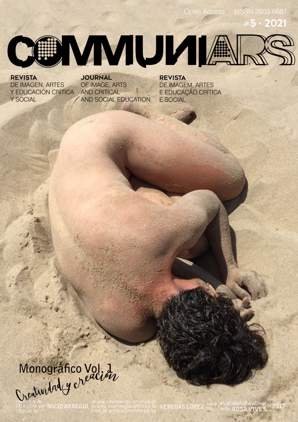Arte, creación y creatividad: entre la utilidad y la inutilidad en la epistemología occidental
Contenido principal del artículo
Resumen
Tanto para el sentido común como para el académico, la creación y la creatividad son, respectivamente, un principio privilegiado por el campo del arte y una habilidad desarrollada principalmente por los artistas. Así, el arte se ha considerado la actividad por excelencia en la que la imaginación y la creatividad parecen inseparables. Esta concepción se construyó en su totalidad a lo largo del siglo XIX. Sin embargo, teniendo en cuenta la propia historia del arte, los artistas y teóricos no siempre han dado por sentada esta alianza entre la imaginación y la creatividad en el proceso de producción artística, porque hubo (y hay) pensadores que defienden la idea de que la creación/creación artística sería inútil en el trato del ser humano con el mundo y con la vida y, sobre todo, en la constitución del conocimiento.
El presente artículo pretende exponer cómo se han construido históricamente los conceptos relativos a la creación en el arte. Platón no reconocía en el arte de su tiempo ningún principio inventivo, sino de simulación completamente innecesario para el conocimiento, mientras que Aristóteles, por el contrario, percibía en la actitud mimética una potencialidad cognitiva común y necesaria a todos los seres humanos. En el Renacimiento, crear significaba sobre todo recrear y resignificar los principios del arte clásico, aplicándolos al contexto moderno. Sin embargo, fue en este periodo cuando el artista tomó plena conciencia de que su obra, más que la repetición técnica y estilística, requería creatividad en el planteamiento de los temas, sobre todo cuando ese tema era bien conocido. Junto con esta idea de creación, comenzó a surgir la idea del artista como genio inventivo.
Descargas
Detalles del artículo

Esta obra está bajo una licencia internacional Creative Commons Atribución-NoComercial-CompartirIgual 4.0.
Los textos e imágenes publicados en la presente revista están bajo licencia Creative Commons (BY-NC-SA. 4.0 Internacional), salvo aquellas obras visuales que el/la autor/a señale con otra licencia y permiso. En este caso la coordinación de la revista queda eximida de la responsabilidad legal que derive de la misma y si no fuera una licencia abierta la obra quedará publicada con derecho a cita o uso justo.
Citas
Aristóteles (2015). Poética. São Paulo: Editora 34.
Bataille, G. (2015). O nascimento da arte. Lisboa: Sistema Solar.
Cappelletto, C. (2012). Neuroestetica – L’arte del cervello. Roma: Editori Laterza, 2012.
Changeaux, J. P. (2013). O verdadeiro, o belo e o bem – uma nova abordagem neuronal. Rio de Janeiro: Civilização Brasileira.
Croce, B. (2016). Estética como ciência da expressão e linguística geral. São Paulo: É Realizações.
Danto, A. (2014). O descredenciamento filosófico da arte. Belo Horizonte: Autêntica Editora.
De Masi, D. (1997). O ócio criativo. Rio de Janeiro: Sextante, 1997.
Durand, G. (1998). O imaginário – ensaio acerca das ciências e da filosofia da imagem. Rio de Janeiro: Difel.
Goody, J. (2011). Renascimentos – um ou muitos? São Paulo: Ed. Unesp.
Harari, Y. N. (2015). Sapiens – Uma breve história da humanidade. Porto Alegre: L&PM.
Huizinga, J. (1999). Homo ludens – o jogo como elemento da cultura. São Paulo: Ed. Perspectiva.
Hyde, L. (2010). A dádiva – como o espírito criador transforma o mundo. Rio de Janeiro: Civilização Brasileira.
Janson, T. (2015). A história das línguas – uma introdução. São Paulo: Parábola Ed.
Joseph, M. (2008). O Trivium – as artes liberais da lógica, gramática e retórica. São Paulo: É Realizações.
Kant, I. (1994). Crítica da razão pura. Lisboa: Calouste Gulbenkian.
Kant, I. (2011). Crítica da razão prática. São Paulo: Martins Fontes.
Kant, I. (2002). Crítica da faculdade do juízo. Rio de Janeiro: Forense Universitária.
Klein, R. & Blake, E. (2005). O despertar da cultura. Rio de Janeiro: Jorge Zahar Ed.
Krauss, R. (2002). Paisajes de la escultura moderna. Madrid: Akal.
Martineau, John (org.). (2014). Quadrivium – as quatro artes liberais clássicas da aritmética, da geometria, da música e da cosmologia. São Paulo: É Realizações.
Medeiros, A. & Pimentel, L. (2013). “Ecossistemas estéticos”. In: Anais do 22 Encontro Nacional de Pesquisadores em Artes Plásticas. Belém: PPGArtes/ICA/UFPA.
Okakura, K. (2008). O livro do chá. São Paulo: Estação Liberdade.
Ostrower, F. (1978). Criatividade e processos de criação. Petrópolis: Vozes.
Ordine, N. (2016). A utilidade do inútil – um manifesto. Rio de Janeiro: Zahar.
Picq, P. (2016). A diversidade em perigo. Rio de Janeiro: Valentina.
Platão (2016). A República. Belém: Edufpa.
Ryckmans, P. (2010). As anotações sobre pintura do Monge Abóbora-Amarga. Campinas: Unicamp.
Russel, B. (2002). O elogio ao ócio. Rio de Janeiro: Sextante.

